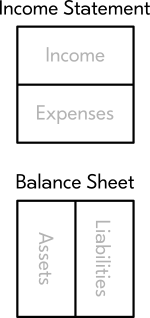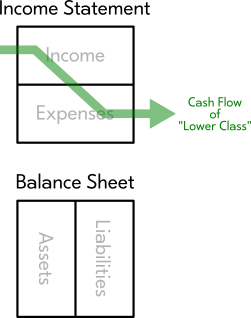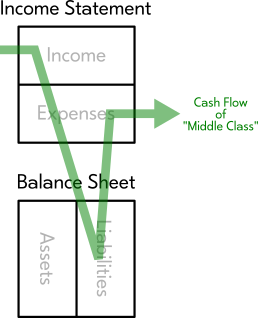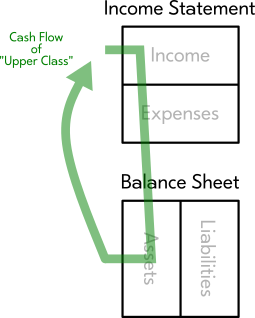Back • Return Home
Guide To Wealth
The following notes are based on Robert Kiyosaki's Guide To Wealth lecture. We will be brief and straighforward, attempting to capture the points that we feel are most vital. However, there is more information within the video.
The Cash Flow Quadrant & Financial Statements
There are generally four different approaches to the making of money:
1. Becoming an Employee (represented here by the letter "E")
2. Becoming Self-Employed (represented here by the letter "S")
3. Becoming a Big Business Owner (represented here by the letter "B")
4. Becoming an Investor (represented here by the letter "I")
Robert arranges these into a grid that he refers to as The Cash Flow Quadrant [The colors don't have any particular meaning; they are just here to make each one distinct.]:
The roles on the left-side of the quadrant tend to be "poorer" than those on the right-side of the quadrant. Certain mindsets and behaviors are fostered throughout society that contribute to that situation. Robert suggests getting a "Financial Education" by developing an understanding of what particular words mean. For example:
• "Income" are ways that money is coming in
• "Expenses" are ways that money is going out, is "spent"
A person's Income has to be more than their Expenses or they end up in debt!
What is that money put into?
• "Assets" are things that generate an Income
• "Liabilities" are things that act as Expenses
Put simply, Assets make money and Liabilities take it away.
These two terms are often confused for one another. For example, a house or car is not an Asset unless it generates an Income (e.g.: by being rented out or used as a taxi). Until they do so, they are a Liability, costing money to maintain.
We will represent Income and Expenses as a box that we will refer to as an Income Statement, and Assets and Liabilities as another box that we will refer to as a Balance Sheet:
We can then show how people's money seems to move through each of them (i.e.: their Cash Flow).
Those who are in the "Lower Class", financially-speaking, usually have a Cash Flow that can be symbolized like this:
All Income is translated directly into Expenses (like when a person lives "paycheck-to-paycheck").
Those who are in the "Middle Class" usually have a Cash Flow that is symbolized like this:
They have extra money that is not lost as an Expense, what some might call a "Disposable Income". However, it is often put into things that eventually become Liabilities (e.g.: luxury items that are not used to make more money).
Those who are in the "Upper Class" usually have a Cash Flow that is symbolized like this:
Extra money is put towards Assets, and the cycle compounds upon itself.
The above is actually a simplified summary of the three financial statements of a business (i.e.: Income Statements, Balance Sheets, and Cash Flow) and how they interrelate. As the above shows, the same principles apply to individual households.
Personal Commentary
The visualization of Cash Flows that is given here might remind one of the movement of energy or matter. This does not seem like mere coincidence. "Econometrics" studies the "metrics", or numbers, behind economic systems (like the Income and Expenses that we have been talking about here). "Thermodynamics" studies the movement, or "dynamics", of heat. Both rely upon the same kinds of mathematical models (i.e.: Statistics). Perhaps useful parallels can be drawn between the two...
Statistics attempts to find patterns within a group by analyzing a smaller part of it. It is used within Econometrics because economic systems have a large number of variables (e.g.: the personal desires of the many people that make them up). The same is true for Thermodynamics (e.g.: the pathways of individual particles within a gas as they are affected by heat). We may not be able to describe every part, but we can make generalizations about the overall system that are accurate enough to engineer with it (like within the topic known as "Heat Transfer").
Ideally, all Cash Flows that go out, go in somewhere else. In other words, one person's Expenses are another person's Income, and vice versa. All of these exchanges should be mutually beneficial, with nothing "earned" by harming another. However, that is not always the case. Inequality is a significant problem throughout society, to the point that greed is both facilitating and speeding up ecological collapse the world over. In order for people to survive, we must intentionally design systems that contribute to life. For example, how can we transform cities so that everyone living there can be continuously fed, clothed, and sheltered through the resources that are already contained within them? We cannot leave this to chance, and it has more to do with understanding than any amount of money.
People are so attached to the very concept of money that it seems "impossible" to live without it, yet one cannot breathe it, eat it, or wear it. How do we escape it? By putting money towards the development of infrastructure that facilitates survival without the necessity of money, we can safely transition out of its use all together. Instead of Assets generating Income, they generate natural resources that are freely shared with All.





